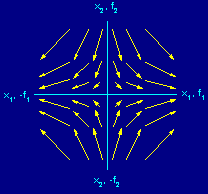
Falk H. Koenemann
Email: Peregrine@T-Online.deD-52064 Aachen, Germany
Phone: *49-241-75885
 |
Falk H. KoenemannEmail: Peregrine@T-Online.deD-52064 Aachen, Germany Phone: *49-241-75885
|
|
The subject of this website is continuum mechanics, or mechanics of solids, or mechanics of condensed matter. The groundwork in the understanding of stress and deformation was initiated in the 17th century, and was essentially finished ca. 1827. These foundations have been refined over time, but they have not been drastically revised. Here, a thought experiment is suggested. Consider the hypothetical situation that we know about theoretical physics today what we actually do know, but for some reason nobody ever spent a minute of thought on stress and deformation. This is going to be done only now. The question is: What would be the very first thought as to how the topic is approached? What is the quintessential aspect of deformation that characterizes it as a physical process, and assigns its proper place in the context of the rest of physics? Would the answer to that question be the same as in 1700 or 1800? I contend that this is not so. Whereas Hooke worked on the "power of springing bodies", Boyle worked on "the spring of the air". They co-authored a paper on Guericke's air pump. Thus they clearly knew they worked on the same problem. However, Hooke's law and elasticity of solids is today understood entirely in terms of Newtonian mechanics whereas Boyle's law is today a part of the thermodynamic equation of state. Both physics and mathematics made giant advances in the period 1840-1900. None of this arrived in mechanics of condensed matter. To give just one example: pure and simple shear deformation are due to different boundary conditions. The systematic understanding of boundary conditions as a systematic issue developed only around 1890; all experiments in the 19th C were done "of course" under orthogonal conditions, where the error does not show. The first simple shear experiments were done in 1909. For simple shear the Euler-Cauchy theory fails systematically and completely in the elastic, plastic, viscous, and brittle field. Up to now, deformation is understood as a change of shape. Here I make the point that by nature, elastic deformation of solids is a change of state in the sense of the First Law of Thermodynamics. But nothing in the theory of continuum mechanics suggests that it is so. It is entirely pre-thermodynamic. This point is explained in detail on this homepage, and an alternative is offered. It will be shown that the Euler-Cauchy theory does not have a valid work term; it is therefore wrong by defnition. One of the successes of the approach offered here is the identification of an instability at the transition from the elastic-reversible to irreversible material behavior. This instability is a strong candidate for the origin of turbulence, and its geometric properties permit the precise prediction of cracks in solids. For an ultra-short five-point summary of my critique of the Euler-Cauchy theory I gave a 15 minute talk on the international DRT conference (Deformation-Rheology-Tectonics) in Barcelona on 9 July 2024 with the essentials of my critique of the Euler-Cauchy theory, plus a condensed outline of the new approach (Koenemann 2008-1, see "paper presentation"). The script here is the talk in written form, designed to be easily understandable. Conference talk: Physics of anisotropic loading
Last update: 20 April 2025 |